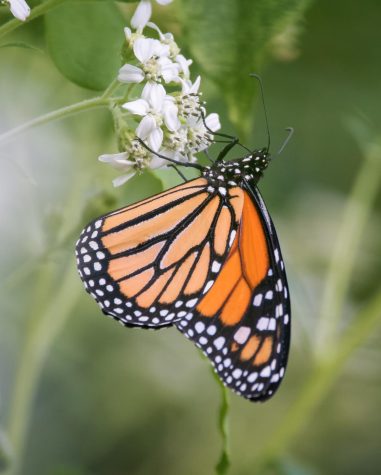Monarch butterflies in decline on campus
Environmental changes are likely explanation and should serve as a warning
In the courtyard at Boone, there are various plants growing including common milkweed, which is vital for monarch butterflies. Milkweed is the only plant monarchs can lay their eggs on and the only plant that caterpillars can grow on.
May 15, 2023
The environment in northern Kentucky is changing according to science teacher Lenny Beck and his environmental science classes.
Beck and his students have noticed a decrease in the monarch butterfly population which is a threat to the ecosystem.
“When you start to see large decreases in any species of butterflies, bees, flies, etcetera, then warning bells should go off,” Beck said.
In the fall, Beck takes his students out to the courtyard to search the milkweed plants for monarch eggs and caterpillars. Over the years, they have been increasingly hard to find when they were once abundant around here.
In the courtyard at Boone, there are various plants growing including common milkweed, which is vital for monarch butterflies. Milkweed is the only plant monarchs can lay their eggs on and the only plant that caterpillars can grow on.
Within the last six years, Beck has planted about 50 common milkweed plants around school property, and only 40 of those plants survived and have continued to grow. Swamp milkweed and butterfly weed have also been planted, but they have not established as well as the common milkweed, according to Beck.
A decline in milkweed can be linked to higher temperatures that stress the plant and cause it to close up and preserve water. This however stops growth of the plant and reduces the nutritional value that monarchs would be getting from it.
Milkweed isn’t the only important plant that monarchs need. The fir trees in Mexico provide safety from the rain and chill temperatures of winter while the butterflies are on their migration journey.
Beck suspects that the illegal logging of the Oyamel Fir Forest in Mexico is impacting the monarchs.

With the loss of habitats and breeding grounds, the monarch population is suffering. The issues in the ecosystem will not just affect the monarchs, it will also affect human society according to Beck.
As a pollinator, monarch butterflies have an important ecological role they need to fulfill in order to keep a balanced ecosystem. In order for the species to survive, it needs to have a minimum population of 30,000 butterflies.
The monarch populations have dropped from around four million to 30,000 within the last 40 years.
“Most flowering plants, including many of the plants humans eat, can’t reproduce without them (monarchs),” Beck said. “However, every loss impacts the stability and resiliency of an ecosystem. We rely on healthy ecosystems to help support human society.”
The loss of the monarch butterfly would also bring losses of other species. Birds such as black-backed orioles and black-headed grosbeaks rely on the butterflies as a food source.
The impact that monarchs have on the environment may seem small, but without the help of the insects, the ecosystem would start to unravel.
The observations of Beck’s environmental science class are an example of the environment changing.
The monarch butterfly is a small but important part of the ecosystems that North America relies on.
